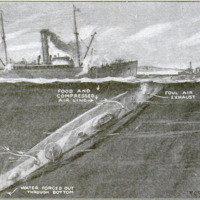-
Title (Dublin Core)
-
A sinking British submarine was saved using compressed air
-
Article Title and/or Image Caption (Dublin Core)
-
Title: Compressed Air to the Rescue
-
Subtitle: How a submarine, sunk in ninety feet of water, was raised and its crew saved
-
extracted text (Extract Text)
-
THE British had a rod in
pickling for the German
Grand Fleet if the Kaiser's sea
force had ventured forth again. To
be specific, the instrument of chastise-
ment consists of a flotilla of very large
submarines of a new type, and the pur-
pose for which these boats were built
was the forming of a mobile ambuscade
just where the foe would be "least
likely to look for under-water erat.
They were designed to have exception
ally high surface speed, and to be cap-
able of accompanying a battle squadron
to distant zones of operation offshore,
and there to submerge and lie in wait
for the enemy's armored squadrons.
The present story has nothing to do
‘with the details of construction of these
powerful submarines other than to say
that they are not propelled by internal
combustion engines, but are driven,
instead, by steam-turbines when oper-
ating at the surface —steam making it
possible to attain greater speed, and
possessing other technical and military
advantages.
Spectacular Feat of Salvage Corps
Now, one of the conditions that
have handicapped the employment of
steam in submarines has been the great
amount of heat radiated by the boilers,
and the well-nigh insufferably high
temperature of the boiler and engine
spaces; and it is upon this fact that the
present story turns. Several months
ago, the British authorities gave an
outline of some of the spectacular work
carried out to |
successful cli-
maxes by the |
Salvage Section
of the Admiral-
ty. Among these
performances
was the raising, |
by means of
compressed air,
ofa vessel which
had gone to the
bottom in water
ninety feet deop.
The public re-
port did not de-
seribe the type
of craft; but it
has since be-
come known
that the vessel
in question was
one of the big
steam-driven
submarines
mentioned.
The boat
foundered on her first deep-water trial
trip: to be exact, she went to the bot-
tom when making her initial dive. She
had aboard of her at the time not only
a full crew but nearly double that
‘number, and among the extra personnel
were certain high officials of the Ad-
miralty. There were fully ninety peo-
ple inside of her when she was headed
seaward.
A Strange Oversight
Tt is not certain whether the presence
of so many inquiring spectators or the
newness of the crew led to confusion
and oversight at a critical stage of the
maneuvers, but it is known that the
primary cause of the disaster was the
failure to close some of the ventilators
over the boiler and engine spaces be-
fore the boat submerged !
Tn all probability, the steam plant
heated the craft to an uncomfortable
degree, and in order to secure relief
the ventilators were kept open aft, and
this was forgotten during the execution
of certain orders immediately preced-
ing the fateful dive. As a result, the
vessel no sooner settled below the sur-
face than water poured in violently
through the unsealed ventilators; and,
before the descent of the submarine
could be halted, hydrostatic pressure
increased the speed and force of the
invading flood, sending her bottomward
like a dropping stone.
Half of the people on board, those
in the space aft, were drowned.
Those forward were trapped and
seemingly doomed.
Happily, the submarine was under
escort, and the bubbles of air escaping
surfaceward steadily from a fixed posi-
tion occasioned alarm. Divers were
promptly brought to the site and sent
down. They discovered the foundered
boat. Their hammer blows upon the |
hull were answered by tappings from |
within the unflooded interior, and
signals were exchanged telling the |
mature of the accident and the predica-
ment of the survivors.
Fresh Air Forced In
The first concern was to save the
lives of those in the forwawd half of
the boat, and it was realized that air
would have to be supplied them be- |
fore the confined atmosphere became |
too foul to sustain life. To this end, |
hose connections were made through |
the outer deck by way of existing fit-
tings, and fresh air was forced into
the vessel while the tainted air was
withdrawn at another point. From
time to time, liquid food was sent
down through the hose to the impris-
oned men. These relief measures were
continued for a day or more. |
In a somewhat similar manner, com-
pressed air was forced into the flooded
after half—entering through the top |
of the pressuroresisting hull and |
driving out the contained water
through an opening which was cleared
in the under side of the submarine's |
shell. Sufficient
buoyancy was
finally obtained
in this manner
to cause the
boat to bring
her bow above
the surface.
‘Then, by means
of oxy-acetylene
torches, an
opening was cut
in the exposed
deck and a way
cleared for the
escape of the
forty-five survi-
vorswithin. The
submarine was
next towed to
port, dry-dock-
ed, and refitted
for service.
This salvage
achievement
stands without
a parallel.
-
Contributor (Dublin Core)
-
Robert G. Skerrett (Article writer)
-
Language (Dublin Core)
-
eng
-
Date Issued (Dublin Core)
-
1919-02
-
pages (Bibliographic Ontology)
-
54
-
Rights (Dublin Core)
-
Public domain (Google digitized)
-
Archived by (Dublin Core)
-
Davide Donà
-
Marco Bortolami (editor)
 Popular Science Monthly, v. 94, n. 2, 1919
Popular Science Monthly, v. 94, n. 2, 1919
 Screenshot (527).png
Screenshot (527).png
